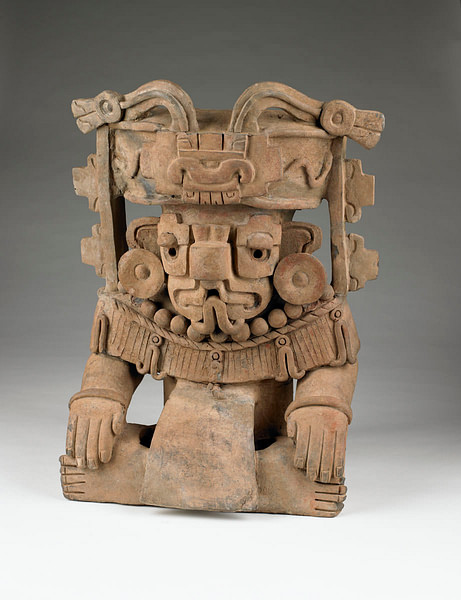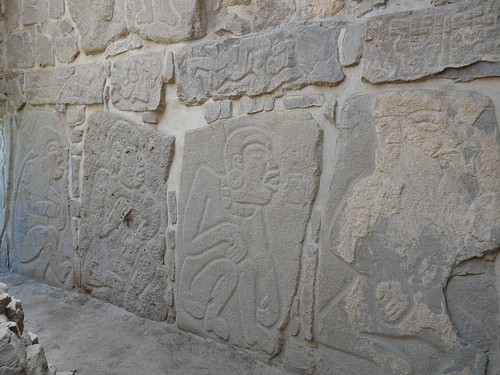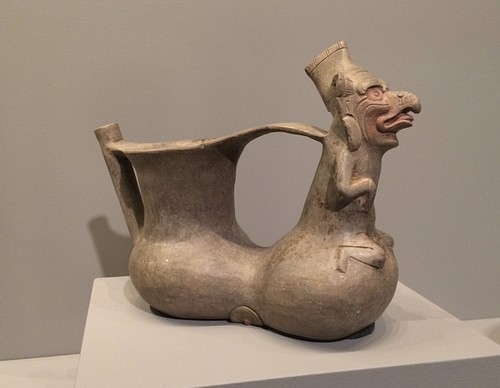Is the Use of Symmetry Common in Zapotec Architecture and Art
The Zapotecs, known as the 'Deject People', dwelt in the southern highlands of key Mesoamerica, specifically, in the Valley of Oaxaca, which they inhabited from the late Preclassic menstruum to the end of the Classic catamenia (500 BCE - 900 CE). Their capital was first at Monte Albán and then at Mitla, they dominated the southern highlands, spoke a variation of the Oto-Zapotecan language, and profited from trade and cultural links with the Olmec, Teotihuacan and Maya civilizations.
Origins & Development
The Zapotecs grew from the agricultural communities which grew up in the valleys in and around Oaxaca. In the Preclassic menstruation they established fruitful trade links with the Olmec civilization on the Gulf Coast which allowed for the construction of an impressive capital site at Monte Albán and for the Zapotec to dominate the region during the Classic period. The urban center, strategically placed overlooking the iii chief valleys, evolved over centuries, get-go effectually 500 BCE and remaining the cultural centre until the demise of the civilisation around 900 CE.
Zapotec cities show a high level of sophistication in compages, the arts, writing and engineering science projects.
The Zapotec had other significant settlements besides the capital and over xv elite palaces have been identified in the surrounding valleys. Indeed, the Zapotec may exist divided into three singled-out groups: the Valley Zapotec (based in the Valley of Oaxaca), the Sierra Zapotec (in the north), and the Southern Zapotec (in the southward and east, nearer the Isthmus of Tehuantepec). The major Zapotec sites, spread beyond the Y-shaped Valley of Oaxaca, include the capital letter Monte Albán, Oaxaca, Huitzo, Etla, San Jose Mogote, Zaachila, Zimatlan, Ocotlan, Abasolo, Tlacolula, and Mitla. The latter would become the most important Zapotec metropolis from c. 900 CE and is notable for its buildings arranged around plazas which are richly decorated with reliefs of geometrical designs.
By the late Preclassic menses Zapotec cities show a high level of sophistication in architecture, the arts, writing and engineering projects such as irrigation systems. For example, at Hierve el Agua at that place are artificially terraced hillsides irrigated by extensive canals fed past natural springs. Show of contact with other Mesoamerican cultures tin can exist seen, for example, at the site of Dainzu, which has a big stone-faced platform with reliefs showing players of the familiar Mesoamerican ball game wearing protective headgear. We also know of very shut relations between the Zapotec and the peoples based at Teotihuacan in the Bowl of Mexico. Indeed, at Teotihuacan there was even a quarter of the city specifically reserved for the Zapotec community.

Cocijo
Religion
The Zapotec pantheon is every bit rich and bewildering as any other Mesoamerican religion is to modern eyes with the standard deities for such of import agencies on the homo condition as rain, sunday, wind, earth, and war. Some of the most important gods were the Bat-god - the god of corn and fertility, Beydo - god of seeds and air current, Cocijo (who had a human body with jaguar and ophidian features with a forked tongue) - the rain and lightning god, Pitao Cozobi - the corn god, Copijcha (symbolised past the macaw) - the god of the sun and war, Coquebila - god of the world's centre, Huechaana - a female parent goddess also associated with hunting and angling, Kedo - god of justice, Ndan - the androgynous god of the oceans, Pixee Pecala the god of love, and Coqui Xee - the creator god who represented infinity.
In addition, individual cities oftentimes had their own patron deities, for example, Coquenexo ('Lord of Multiplication') patron of Zoquiapa, Coqui Bezelao and Xonaxi Quecuya (gods of expiry and the underworld) patrons of Mitla and Teocuicuilco, and Cozicha Cozee (another war god) patron of Ocelotepec.
Offerings, prayers and sacrifices were offered to these deities in the hope of their favourable intervention in human being affairs, for example, to bring rain vital for crops, to end droughts or bring fertility to the land and its population. Likewise, in common with other Mesoamerican cultures, the Zapotec had 20 twenty-four hour period names represented by diverse glyphs such as Chilla (crocodile), Pija (drought) and Xoo (convulsion); in one case once again they ofttimes correspond the cardinal elements that could drastically affect daily life.
Monte Albán
Built on a series of mountain plateau at an distance of 400 m, the city of Monte Albán was the residential, ritual and economical centre of the Zapotec civilisation. It replaced, betwixt 500 and 450 BCE, San José Mogote every bit the most important settlement in the Valley. It besides became the burial site of Zapotec kings for over a thousand years. The city particularly flourished in the late Preclassic period when its population was as high as 20,000 people and again betwixt 400 and 700 CE when the population rose to 25,000 and the urban center ruled over some one,000 settlements spread beyond the Valley.
The majority of the structures visible today on the master plaza appointment to the Classic menstruum with the notable exception of the Temple of the Danzantes, a stone platform construction which was constructed when the site was first occupied (Monte Alban I). The name Danzantes derives from the dancing relief figures decorating the platform. 300 figures are identifiable, some seem to be old, single-toothed males, some take been mutilated, whilst still others seem to be almost swimming - who they represent is not known. Other relief stones from the temple too provide the first certainly identified written texts in Mexico showing an alphabet with semantic and phonetic elements (as nevertheless undeciphered). There is also a system of numbers represented by dots and bars and glyphs for the 260-twenty-four hour period year based on twenty day names and 13 numbers with the 52-yr bike of the Calendar Round.

Danzantes, Monte Alban
Finds at the site from this catamenia include a large quantity of pottery, usually fabricated with a fine grey clay, sometimes with incised figures similar to the Danzantes, and typically in the form of spouted vases and bowls assault a tripod. Another interesting type is the whistling jar, a jar with two chambers which when used to pour liquid, expelled air from the 2d bedchamber to create a whistling audio. The Zapotec were as well skilled sculptors and single effigy figures, groups of figures and urns survive both in clay and more precious goods such as jade.
The metropolis farther developed betwixt 150 BCE and 150 CE to create Monte Albán II. Dating from this phase is a large stone-faced building shaped like an arrow head (Edifice J) which points southwest and is aligned with the Capella star. The building is covered with carved text and reliefs which point regional conquests, illustrated by the upside down heads of defeated kings.
In the subsequent Classic period Monte Albán III arose and, influenced by Teotihuacan, saw the construction of an I-shaped ball court and the Temple-Patio-Altar complex that would exist copied at sites across the Valley. In addition, over 170 hole-and-corner tombs have been excavated, many with vaults and antechambers with richly painted walls, which adjure to the wealth of the city. The tombs also evidence signs of beingness regularly re-opened, illustrating the Zapotec preoccupation with ancestor worship.

Zapotec Double-chambered Vessel
Reject
Quite why the city and the Zapotec culture collapsed at Monte Albán is not known, just that there is no trace of violent destruction and that information technology was contemporary with the demise of Teotihuacan and a general increment in inter-country conflict. The site continued to be significant, though, as it was adopted by the later Mixtec every bit a sacred site and place of burial for their own kings. The Zapotecs did not disappear completely, however, for in the early Post-Classic period they established a new, smaller centre at Mitla, known to them as Lyobaa or 'Place of Residuum' which as well had many fine buildings including the celebrated Hall of the Columns. The site connected to be occupied fifty-fifty up to the Castilian conquest.
This article has been reviewed for accuracy, reliability and adherence to academic standards prior to publication.
Source: https://www.worldhistory.org/Zapotec_Civilization/
0 Response to "Is the Use of Symmetry Common in Zapotec Architecture and Art"
Enviar um comentário